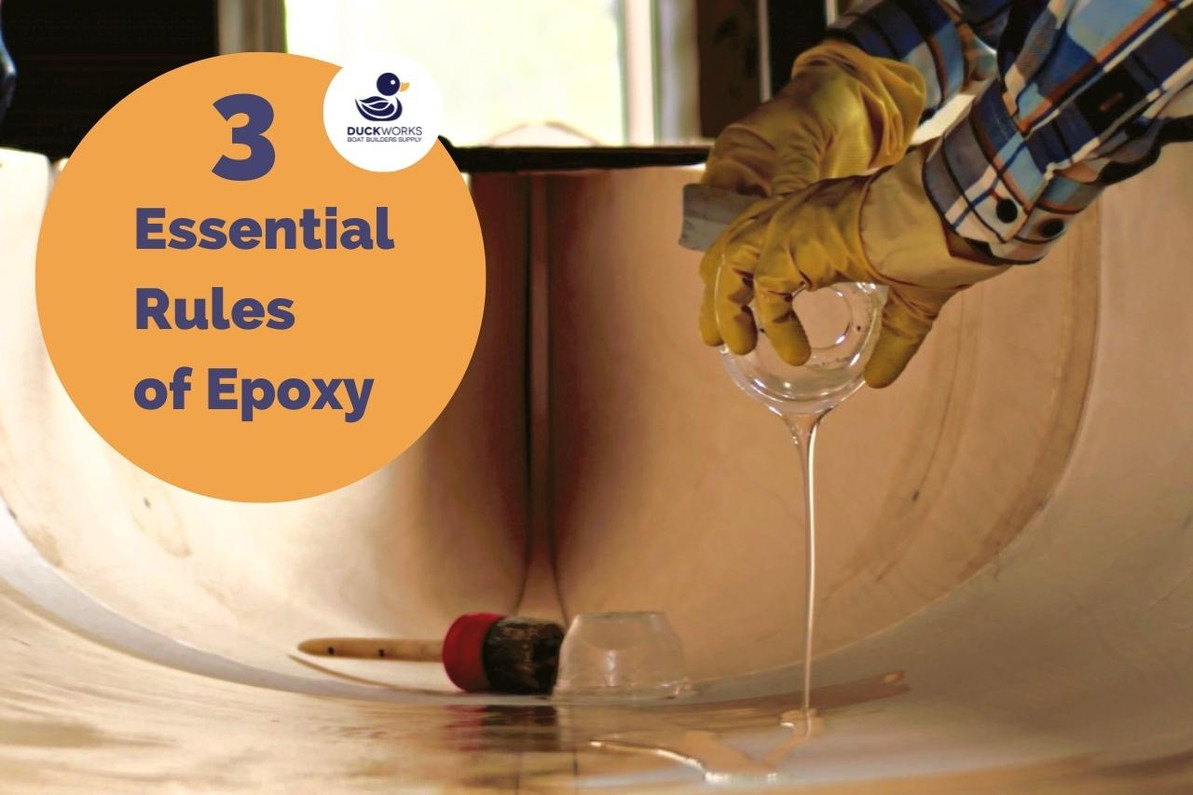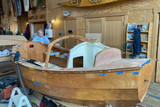3 Essential Rules of Epoxy
A lot of new boatbuilders are a bit intimidated by the idea of working with epoxy. If you follow these three very basic rules you will be on the road to epoxy success, so let’s dig into each a bit.
Rule #1: Keep it off of you
The first rule has to do with the safety aspect of working with epoxy. Epoxy is a sensitizer, each time you get it on your skin you get increasingly sensitized to it. The more sensitive you are to it, the more and more likely you are to develop issues from the exposure. Some folks find that a single exposure is more than their body wants, but others work with it for years with no noticeable issue. Skin irritation, swelling, rash etc are some of the symptoms a person may experience, and to varying degrees.
Epoxy sensitivity is no joke, but it’s also nothing to be afraid of if you take measures to avoid contact. Wearing Nitrile gloves goes a long way to limiting exposure. The nitrile is more effective at blocking more “bad” stuff than basic latex gloves, and forget about the clear, thin plastic-y gloves, they tear way too easily. The nitrile gloves are disposable, but there’s no reason why you shouldn’t clean them up after each use, with care you can use the same gloves for quite a while. (But toss them if you get a tear.)
Best practice is to wear a respirator with organic vapor filtration, a combo VOC/dust filter is perfect. The epoxy is not particularly stinky or offensive to work with, but if you have a pot kick-off you will see smoke and I don’t know about you, but nothing about chemicals getting hot enough to smoke says, “inhale deeply.” And the additives you mix into epoxy, like silica and wood flour should be kept out of your lungs. If you use a VOC filter, I recommend taking them off after each use and putting them in an airtight container or bag to extend the life of the filter.
Next level of “keep it off of you” is to give some thought to the clothes you wear when working with epoxy. Because no matter how neat and clean you are, you will get it on your clothes, and there’s no getting it out. So a pair of coveralls is handy, or tyvek sleeves and aprons, you get the idea. If you have long hair, pull it back. And while I’ve never had epoxy splash, it’s pretty viscous, a pair of shop glasses or goggles could come in handy.
If you do get some epoxy on you it is standard practice to physically remove as much as you can with a dry cloth or paper towel, taking care not to spread it around. Then wash the area with warm/soapy water. A quick follow up rinse with white vinegar is a final step that all but ensures you are clean. I don’t recommend using harsher solvents in direct contact with your skin. But, so you know, Denatured Alcohol is the next level of clean up for epoxy. You will use this a lot when cleaning tools, prepping surfaces in advance of coating, glueing, filleting etc… And the next is Acetone, which I don’t like to use, and in most instances Acetone and other more aggressive solvents simply aren’t necessary.
If you take these simple measures you can safely work with epoxy, no fear required.
Recommended supplies for Rule #1: Keep it Off of You...
Rule #2: It Takes Two to Tango
Epoxy is a two component product, resin and hardener. You will always start with measuring out these two components, followed by thoroughly mixing them. Both of the epoxy manufacturers that we warehouse, Raka and System Three (Silvertip) are measured two parts resin and one part hardener by volume (you can measure by weight too, but that’s not quite as straightforward).
That 2:1 ratio is critical, don’t vary from that. More hardener does NOT make the reaction go more quickly, and less does NOT make it go slower. The main way in which you control the speed of the curing process is by choosing various hardener speeds: slow, medium and fast. The correct volume of each component is needed in order for the product to harden properly. If you are unsure as to whether or not you got the ratio correct or not, it’s best to abort and start over with a fresh batch. Put that questionable batch outside on something non-flammable and let it be. Hopefully it kicks enough to go in the garbage tomorrow.
No matter what you’re going to do with a batch of epoxy, glue, coat, fillet etc… you always start with accurately measuring and mixing the two components thoroughly. From there you can wet out your glass cloth, mix in your fillet blend or graphite, it’s incredibly versatile stuff and perfectly matched with plywood, solid lumber and fiberglass.
You can buy the epoxy components individually, but we also offer them in convenient kits, including kits for specific boats.
Recommended supplies for Rule #2: It Takes Two to Tango . . .
Rule #3: Get it Out of the Cup
The moment you start mixing the two components together the clock starts ticking. This is one of the things that folks are most nervous about, understandably so. I’m no chemist, but I know that when you get epoxy resin and hardener mixed in the correct proportions in your cup they start getting excited.
The larger the batch in your cup, the faster the chemical reaction wants to go off. So start out with small batches. Epoxy is not like paint—you don’t need to keep a “wet edge”—so you can mix a small batch, get it out of the cup and into use. The right epoxy tools can make the small-batch work a lot easier (our 16 oz measuring cup is perfect for this). The reaction slows way down once you have reduced the consolidated volume.
Here's a perfect scenario to help explain this—say you’re glassing the bottom of your boat. You’ve got the glass all laid out dry, you have all of your personal protective gear on, rollers and spreader are at the ready and you mix up a batch of epoxy. You mix thoroughly for two minutes and then take a phone call, setting down your pot of epoxy. By the time you’re off the 15 minute phone call, you notice that your pot of epoxy is smoking. Epoxy wasted, do not attempt to use it! Next time don’t answer the phone, let it go to voicemail and get that epoxy out of the cup, either carefully “dumped” onto the boat or into a roller tray and then onto the boat. Getting it out of the cup is key—the clock slows way down once you have the volume spread out.
Recommended supplies for Rule #3: Get it Out of the Cup . . .
To recap, my three essential rules are:
1) Keep it off of you
2) It takes two to tango
3) Get it out of the cup
By now you’re probably thinking “Isn’t there a lot more to working with epoxy?” Well, the short answer is yes, and I’ll go into more in upcoming blog posts. But I see these as foundational rules; everything else builds on top of these basics. And truly, my first rule is “Go to the bathroom before you mix epoxy,” so toss that in and you’ve got the basics.
Recommended reading for those who want to learn more:
Not sure how much epoxy you will need? Click HERE. Not sure which brand to buy? Click HERE.
Recent Posts
-
Duckworks Takeover 2024 at NWMC!
We're excited to share some fun boat builds from this year's Duckworks Takeover at the Northwest …Apr 13th 2024 -
Sail Into Spring with New Boat Designs
Ahoy there, fellow DIY boat builders! With spring on the horizon, it's the perfect time to set sa …Mar 4th 2024 -
R2AK Under 20' Side Bet Winner - Wave Forager!
There's a well-known folk adage out in the world, 'The proof of the pudding is in the eating.' Bu …Aug 9th 2023




